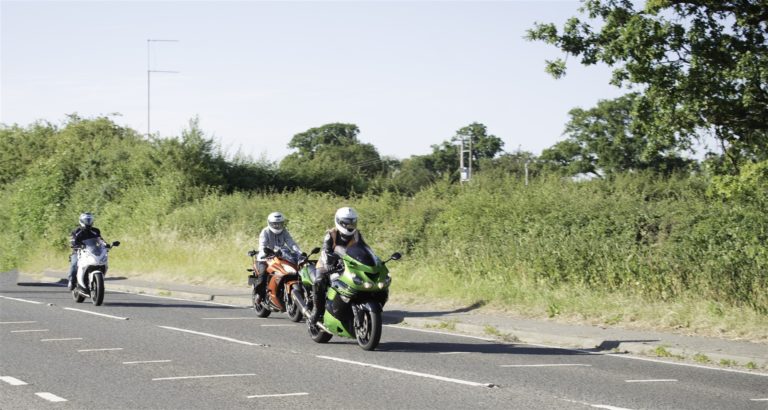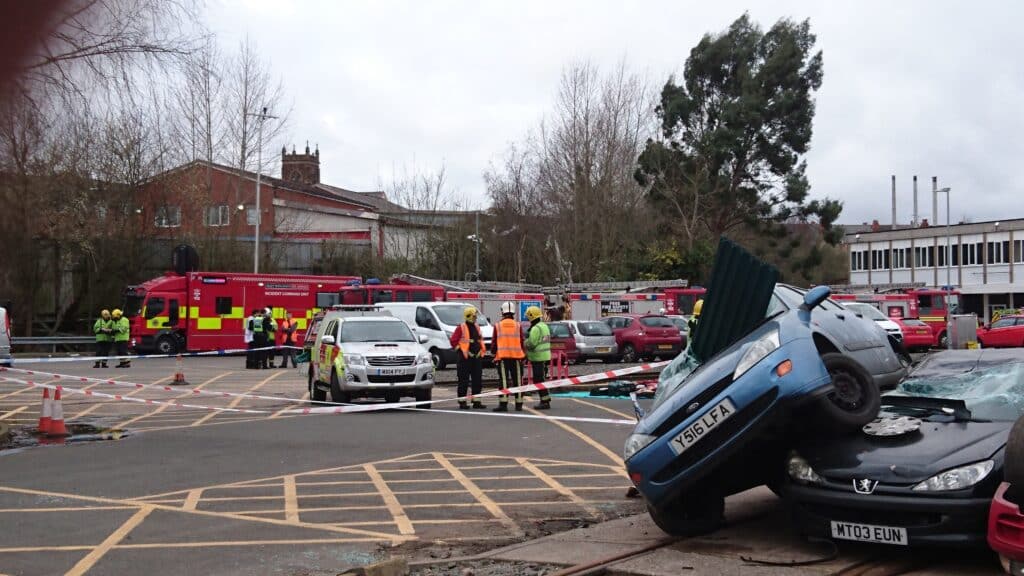

Being the first responder at a motorbike accident scene can be an unnerving and intense experience. Yet, it is crucial to manage these situations effectively to prevent further harm.
“Biker Down”, a training program initiated by the Fire and Rescue Service, offers practical insights into accident scene management for bikers.
It is a very worthwhile course and should be taken by every rider in the UK. It is free to do and gives some very important information about what you can personally do to help at the scene of an incident involving a motorcyclist.
However, you can put this knowledge into practice at any Road Traffic Collision (RTC) and help, especially if you get there and noone else has taken charge of the situation.
One of the first things that “Biker Down” emphasises is effective scene management.
This involves assessing the situation, making the scene safe for the injured and other road users. It teaches you the skills required to implement necessary measures to prevent further accidents or the situation escalating.
Until the emergency services arrive, scene management often requires assessing the situation, quick thinking, calmness and strategic decision-making. You have to detach yourself for a moment to analyse what is going on to make decisions based on ensuring the safety of everyone involved and preventing further problems.
Adrenaline can be both a friend and foe in emergency situations. It sharpens your senses and reactions but can also lead to panic and impulsive decisions.
Effective adrenaline management focuses on staying calm and composed. It allows you, if controlled correctly, to have some rational amidst the chaos. This will enable you to make informed decisions under extreme pressure.
The importance of dynamic risk assessment in accident scenarios cannot be overstated. This means a continuous process of identifying hazards and taking action to eliminate or reduce risk.
This is not easy for someone who is not properly trained to deal with extreme situations but with a small amount of knowledge you will be a great help at a chaotic scene.
You should constantly be monitoring and reviewing the situation as things could rapidly change and make the situation you are dealing with worse.
You need to be able to quickly identify potential dangers like leaking fuel, oncoming traffic, or unstable terrain. The ability to assess risks quickly can significantly contribute to maintaining a safer accident scene and prevent further injury.
Deciding where to park your bike or car is vital. You need to ensure that your vehicle does not add to the hazards at the scene. If required, you can use your vehicle as a shield of protection but if this is not necessary look for an alternative place.
A safe location if not for protection of the scene could be downstream of the accident. You can move to the side of the road but remember the emergency services will need somewhere to stop once they arrive.
Keeping an area clear or creating space for them when they arrive should be in your mind when dealing with other traffic.
Knowing who to call and the information required by emergency services is fundamental. In the UK, you would typically dial 999 for emergency services. Depending on what is wrong will depend on who you call.
You will need to know important details to relay to the operator. These will include the location (use your phone to get pinpoint accuracy), a brief description of the nature of the incident, number of casualties that you are aware of and any immediate risks at the scene.
You may also be asked a number of other questions to help the operator decide on what else may be needed to help manage the situation. You will be on your own in the early stages of the incident, so keeping a calm head and asking others to do tasks will help get the situation under control.
Managing other traffic is critical to prevent additional accidents. If you are on a bend, other traffic may come across the scene suddenly, it is important to have help slowing down and moving traffic that does not need to be there.
It may be an idea to ask car drivers if they have first aid experience. Sometimes off duty emergency personnel, doctors or nurses may stumble across the situation. Their input can be vital until the ambulance arrives.
If possible, position two people either side of the scene of the accident to direct traffic. It is important they work together to keep traffic flow, or to block the road if necessary.
Look around for other hazards such as overturned vehicles, fuel leaks, fire risks or any other objects at the scene that could cause further harm.
Always try to get help with any available resource, like first aid kits, blankets and help from bystanders who can assist. Quick thinking to start controlling the scene is vital, tell people what you want them to do specifically and they will generally do what they are told to help the situation.
It’s essential to be aware of your legal obligations. This includes stopping at the scene and calling the emergency services if it has not already been done.
If you are involved or witnessed the incident you must provide details. If the scene has already been managed and you cannot help if you arrive later, ask if there is anything you can do to help. If not you may be directed to continue with your journey.
The “Biker Down” course offers first aid training specific to motorcycle accidents. It won’t turn you into a professional in the day’s guidance but will give you an insight into what to do to keep casualties alive.
You’ll learn how to approach a casualty safely, when and how to remove a helmet. You’ll receive information about how to stop major bleeding and how to perform cardiopulmonary resuscitation (CPR).
These skills could mean the difference between life and death at an accident scene. It is important to role play and understand what and how to do things that will help.
The program also explores the science behind being seen on the road. It educates bikers about the danger of motion camouflage, the looming phenomenon and how the human eye and brain can be deceived in certain situations.
Advice on how to improve conspicuity and making yourself more visible on the road is also discussed.

The “Biker Down” program is a guide that equips bikers with the skills and knowledge needed to manage an accident scene effectively. If you are one of the first on scene and have to help control the situation.
Understanding these aspects can significantly improve the safety of motorcyclists and help save their life. If a number of your group have done the course together, you can easily control any scene with the help of friends who know what to do.
If you ride as a group, it is a good thing to discuss what you might do at the scene of an incident. This is not unlike the emergency services practising for an incident.
Approaching the casualty safely is a crucial part of accident scene management. You will need to ensure your own safety before you can help others. This is a key principle, as you cannot help if you become a casualty yourself.
Assess the situation from a distance, try to detach yourself from the scene to be able to do this objectively, quickly and decisively. Look out for other potential hazards and only when you’re confident it’s safe, approach the casualty. Or get someone else to approach them if you have become the scene manager.
You must be aware of the potential risks at the scene, these include the road speed of traffic approaching the scene. Is there a fire risk from any vehicles or a chance of something moving (like an overturned vehicle) while you are dealing with a casualty.
Knowing when and how to remove a motorcyclist’s helmet is critical. This should only be done if the person is not breathing and requires resuscitation. Otherwise, talk to them for reassurance and tell them what is going on and what you are doing.
In a situation where removing a helmet is necessary, care must be taken to minimise movement of the head and neck. Without doing this carefully, it could potentially worsen any spinal injuries. However if they are not breathing you must do something.
In a motorcycle accident, it’s quite possible that a rider could have significant bleeding from injuries or an open wound. You must apply direct pressure to stem the flow of blood, regardless of how much it may hurt.
Also get a clean cloth or any material that can be used to cover and then bind the wound. It is essential to try and control the bleeding until medical professionals arrive. It’s essential to have some knowledge of first aid to handle such situations.
Cardiopulmonary resuscitation (CPR) is a life-saving technique used when someone’s breathing or heartbeat has stopped.
As part of the “Biker Down” course, you will learn the correct procedures for performing CPR. It does not make you a professional but will give you an insight into what you can do in this situation to try and save someones life.
Doing nothing is not an option in this unfortunate situation but doing the best you can will have an impact and may be the difference between life and death. If you forget what to do, you should attend further courses to elevate your knowledge and skills.
Understanding the science of visibility is key to preventing accidents in the first place. The ‘Biker Down’ program delves into this topic.
It gives information about the “motion camouflage” phenomenon, where moving objects can appear stationary from a certain viewpoint. It also discusses the “looming effect,” where a fast-approaching object may not be perceived as moving until it’s very close.
Motion camouflage is a dangerous phenomenon for bikers.
This happens when a motorcycle is moving directly towards an observer (like a driver at a junction). It causes the bike to remain stationary in the observer’s field of vision which camouflages its movement.
Understanding this can help bikers take preventive measures to avoid such situations. Moving position can help vehicles at junctions see you as they pick up the movement of the bike in their peripheral vision.
Another critical aspect to understand is the looming phenomenon. This is when a vehicle approaches directly, it can appear to be moving very slowly until it’s dangerously close, leaving little time for reaction.
When looking at a bike head on from a junction when stationary, the bike appears in the distance to be quite small. As it approaches its mass does not seem to increase as quickly as the mass of a car would increase.
Road users can judge speed by the mass growth, the quicker its mass increases – the faster the vehicle is travelling. The slower the mass increases – the slower the vehicle is travelling. This technique improves with experience. This is one of the reasons children get run over when they are young, they do not have this skill yet in their armoury of experience.
Awareness of these visual illusions can lead to safer riding practices, such as better lane positioning and usage of headlights. For riders in this situation, it’s a good idea to move laterally away from the junction. This movement may be picked up by the unsuspecting driver.
Lastly, it’s crucial to understand that the eye and brain don’t always work perfectly in tandem. Yes, the eyes can play tricks on you. You look out for what you usually see.
Perception can often be skewed under certain conditions, such as low light, low bright sunshine or when viewing objects at a long distance.
Being aware of these limitations others have when looking can help you prepare and react better in different situations.
Visibility, otherwise known as conspicuity, is one of the most effective ways to prevent accidents. Wearing high-visibility clothing and using reflective materials will help people see you in different conditions.
In daylight the orange or yellow vest can aid in visibility and at night the reflective strips can reflect light at huge distances. Emergency vehicles are coloured like this for a reason, it wasn’t luck that made them yellow or brightly coloured.
Also keeping the headlights on on older motorcycles will help, modern machines keep the light on dipped-beam when the ignition is turned on. There are also other tips and advice given during the ‘Biker Down’ programme.
Remember, the more visible you are, the safer you are on the road.
The ‘Biker Down’ course provides a comprehensive set of skills that every motorcyclist should possess. It arms you with the knowledge needed to safely manage an accident scene, as well as practical tips to avoid accidents in the first place.
These skills not only increase your confidence as a rider but could also be instrumental in saving the lives of your friends and family. That’s where the ‘Biker Down’ course proves to be invaluable.
But the course doesn’t just prepare riders to react in emergencies, it teaches you how to avoid these situations in the first place. It will help you evaluate how you ride to avoid certain situations and starts an attitude shift once you see the consequences of poor riding.
Become a member today to gain access to our courses and exclusive member content* including:
* Content may differ between each membership

Sorry. You must be logged in to view this form.
"*" indicates required fields